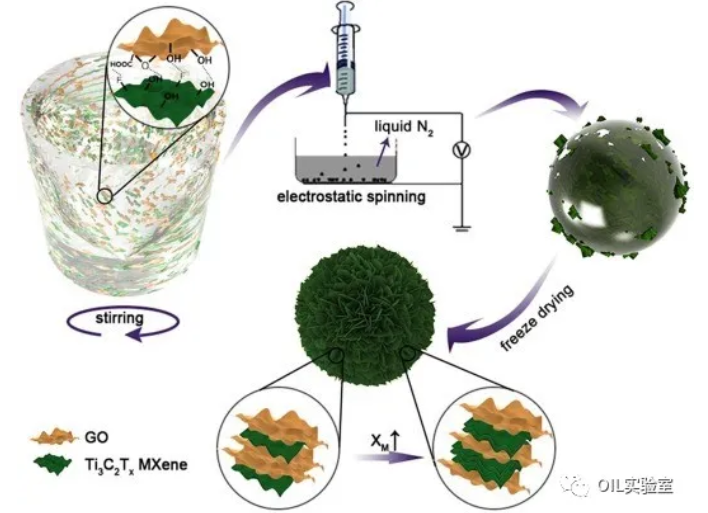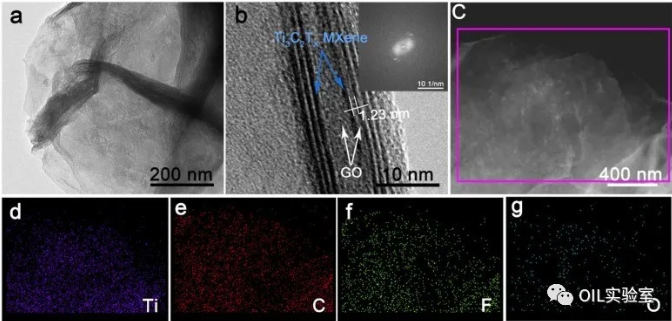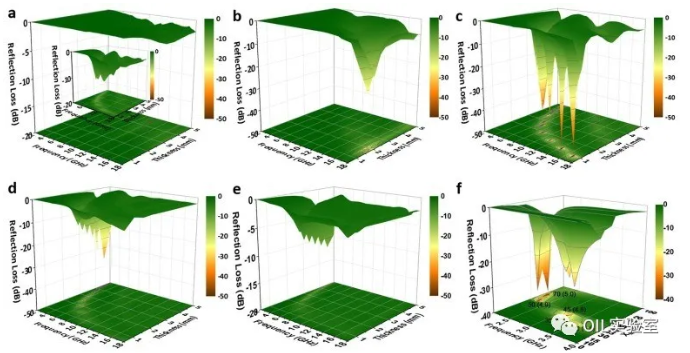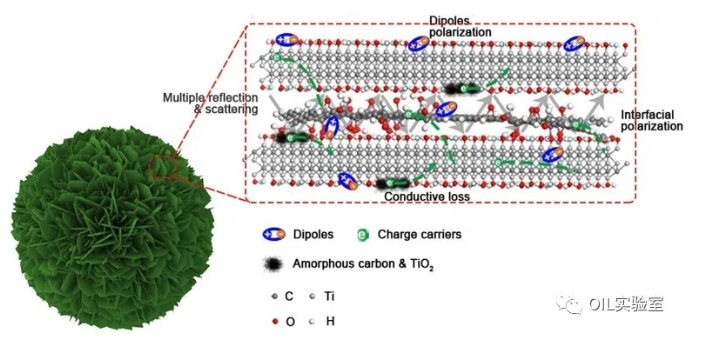
hotline:
17715390137
Tel/Wechat:
18101240246 (Technology)
0512-68565571
Email:mxenes@163.com (Sales Engineer)bkxc.bonnie@gmail.com
Scan the code to follow or search the official account on WeChat:
2D Materials Fronrier After paying attention,
click on the lower right corner to contact us,
Enter enterprise WeChat.
Professional Services Online

Graphene and its derivatives are widely used in the field of electromagnetic protection due to their high dielectric loss, light weight and modifiable characteristics. However, the high conductivity of pure graphene usually leads to problems such as limited loss mechanism and serious impedance mismatch. It can only exhibit superior performance in electromagnetic shielding. Compared with pure graphene, although graphene oxide (GO) has more loss mechanisms, its low conductive loss hinders its electromagnetic wave attenuation ability. In this way, due to the advantages of good impedance matching, rich loss mechanism and strong dielectric loss capability, the research of reduced graphene oxide (rGO) in the field of microwave absorption is more common, but it is still limited by high cost and complex technology. On this basis, assembling two-dimensional graphene layers into three-dimensional structures such as aerogels or foams, by extending microwave reflection/scattering paths, generating multi-polarization interfaces, and adjusting impedance matching, can effectively improve its microwave absorption capacity. When the microwave is incident on the three-dimensional structure, the hole wall can greatly reduce the impedance mismatch with the free space, weaken the reflection and scattering between the adjacent wall and the pillar, and help improve the microwave absorption performance. The chemical activity of GO can be conveniently used to make three-dimensional (3D) structures. In order to obtain better microwave absorption performance, GO usually needs to be doped with conductive or magnetic materials and reduced to a certain extent to achieve efficient carrier transport at the interface.
MXene materials such as Ti3C2Tx are a kind of flexible two-dimensional materials. They have attracted much attention due to their light weight, high conductivity and good surface activity. In particular, the abundant functional groups on the surface allow them to be modified with other materials. Without sacrificing its inherent performance and structural damage. In addition, Ti3C2Tx has moderate dielectric constant and surface activity, and is considered as a potential electromagnetic shielding or absorbing functional medium in GO-based composites. The 3D composite material composed of GO and Ti3C2Tx, due to the newly generated non-uniform interface and layered porous structure, can form medium dielectric loss capacity and optimized impedance matching, and realize the synergy of the inherent loss characteristics of the two-dimensional material and the three-dimensional conductive structure , In order to enhance the electromagnetic wave absorption loss performance. However, how to achieve high-performance GO/MXene composite absorbing materials with a simple process is still a challenge.
Recently, researchers from Southwest Jiaotong University used rapid freezing-assisted electrospinning technology to prepare Ti3C2Tx@GO composite aerogel. The preparation method is shown in Figure 1. During the electrospinning process, the hydrogen bonds between the GO and MXene sheets interact with the growing ice peaks during the rapid freezing process, and concentrate on the grain boundaries to form a three-dimensional network. The morphology after freeze drying is shown in Figure 2. For pure GO aerogels (Figure 2a), the pores are connected randomly and the pore walls are folded; when Ti3C2Tx is added to GO, the pores become regular and the pore walls become straighter (Figure 2b); and when only Ti3C2Tx constitutes aerosol When glued, the hole walls are rough and slightly shrinkage (Figure 2c). This difference is caused by the different stiffness of the GO layer and the MXene layer. The harder MXene layer has the effect of inhibiting the curling of the GO layer during forming. In addition, the size of the GO layer and the MXene layer is very different. The larger GO layer and composite material layer can serve as the pore wall, and for the absorbing material, it must be composed of many MXene layers, which also makes the pore wall frozen. It becomes rough and shrunken in the process. This well-structured three-dimensional composite structure helps to improve the strength of Ti3C2Tx@GO aerogel and prevents deformation during processing. The three-dimensional structure of the composite aerogel was also verified in the TEM characterization, as shown in Figure 3.
The electromagnetic attenuation test results show that the Ti3C2Tx@GO aerogel exhibits excellent microwave absorption performance in the 2-18GHz band (Figure 4). When the loading of aerogel is only 10wt%, the reflection attenuation of the 1.2mm thickness absorber at 14.2GHz can be as low as -49.1dB. More importantly, Ti3C2Tx@GO aerogel also achieved a reflection attenuation of -38.3dB in the S-band low-frequency band, and its matching thickness is 5.0mm. Benefiting from the difference in electrical conductivity between Ti3C2Tx and GO, as well as the heterogeneous interface and abundant surface groups formed by the two, Ti3C2Tx@GO composite aerogel shows excellent impedance matching and electromagnetic attenuation performance. In addition, the unique aerogel structure not only provides the advantage of light weight for the absorber, but also extends the attenuation path after electromagnetic waves are incident. The combination of these features makes it exhibit excellent microwave absorption performance (Figure 5).
In this work, a new type of GO/MXene composite aerogel absorbing material was successfully prepared through the simple process of electrospinning combined with rapid freezing. This composite aerogel material better expands the absorption bandwidth of the GO-based wave absorbing material, making it suitable not only for the C-Ku band but also for the low-frequency S-band under the condition of small thickness and low load. Therefore, this material has potential electromagnetic wave absorption potential in the fields of weapons, satellites and daily protection.

Figure 1. Schematic diagram of the preparation of MXene@GO composite aerogel.

Figure 2. The micro-topography of GO aerogel (a and a’), Ti3C2Tx@GO aerogel (b and b’) and Ti3C2Tx aerogel (c and c’).

Figure 3. TEM (a), high resolution TEM (b) and selected element distribution (c-g) test results of Ti3C2Tx@GO aerogel.

Figure 4. GO aerogel and Ti3C2Tx aerogel (a), and Ti3C2Tx@GO aerogel with different MXene ratios (MXene content b is 10%, c is 30%, d is 50%, and e is 80%) The microwave reflection attenuation. (F) The reflection attenuation of Ti3C2Tx@GO aerogels with different MXene ratios in the S band.
Figure 5. Schematic diagram of the electromagnetic reflection attenuation principle of Ti3C2Tx@GO aerogel

Related papers:
Li, Y., et al. Electrospun generation of Ti3C2Tx MXene@graphene oxide hybrid aerogel microspheres for tunable high-performance microwave absorption. Chemical Engineering Journal, 2020, 391: 10.
Information source: OIL laboratory
This information is from the Internet for academic exchanges. If there is any infringement, please contact us and delete it immediately

| Reminder: Beijing Beike New Material Technology Co., Ltd. supplies products only for scientific research, not for humans |
| All rights reserved © 2019 beijing beike new material Technology Co., Ltd 京ICP备16054715-2号 |